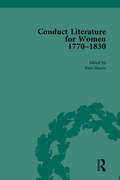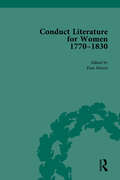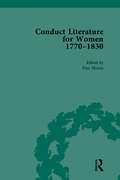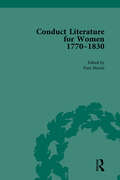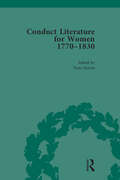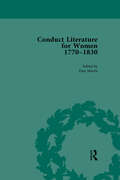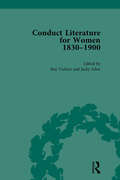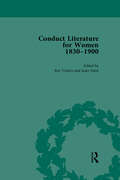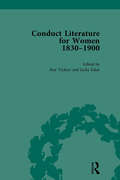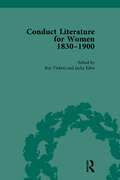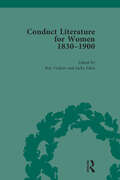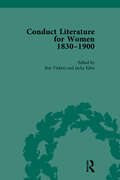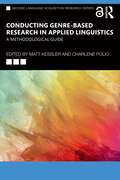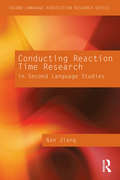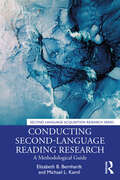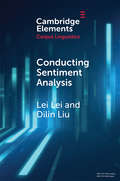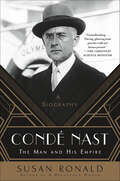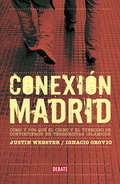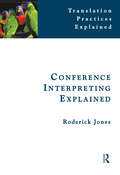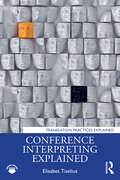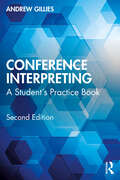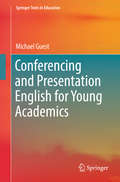- Table View
- List View
Conduct Literature for Women, Part IV, 1770-1830 vol 1
by Pam MorrisThis collection aims to give a chronological insight into the evolution of conduct literature, from its early roots in the Renaissance period through to the dramatically different role that women played at the emergence of the 20th century. The material presented in this six-volume set moves away from courtly etiquette, adopting a more middle-class, domestic focus, and includes facsimile reproductions of sermons, poems, narratives and cookery books.Social and literary historians recognise the 1790s as a moment of political crisis and turbulence in British history: the intense reactions in Britain to increasing revolutionary violence in France politicised almost every aspect of cultural life. At the centre of discursive hostilities was the opposition between sentimentality, on the one hand, and rationality, on the other. Two of the most important literary forms utilised for expressing these polemics were novels and treatises on education, as well as conduct writing. Conduct Literature for Women IV, 1770-1830 makes available this body of writing, which has been less well studied in respect to the war of ideas than the former two.
Conduct Literature for Women, Part IV, 1770-1830 vol 2
by Pam MorrisThis collection aims to give a chronological insight into the evolution of conduct literature, from its early roots in the Renaissance period through to the dramatically different role that women played at the emergence of the 20th century. The material presented in this six-volume set moves away from courtly etiquette, adopting a more middle-class, domestic focus, and includes facsimile reproductions of sermons, poems, narratives and cookery books.Social and literary historians recognise the 1790s as a moment of political crisis and turbulence in British history: the intense reactions in Britain to increasing revolutionary violence in France politicised almost every aspect of cultural life. At the centre of discursive hostilities was the opposition between sentimentality, on the one hand, and rationality, on the other. Two of the most important literary forms utilised for expressing these polemics were novels and treatises on education, as well as conduct writing. Conduct Literature for Women IV, 1770-1830 makes available this body of writing, which has been less well studied in respect to the war of ideas than the former two.
Conduct Literature for Women, Part IV, 1770-1830 vol 3
by Pam MorrisThis collection aims to give a chronological insight into the evolution of conduct literature, from its early roots in the Renaissance period through to the dramatically different role that women played at the emergence of the 20th century. The material presented in this six-volume set moves away from courtly etiquette, adopting a more middle-class, domestic focus, and includes facsimile reproductions of sermons, poems, narratives and cookery books.Social and literary historians recognise the 1790s as a moment of political crisis and turbulence in British history: the intense reactions in Britain to increasing revolutionary violence in France politicised almost every aspect of cultural life. At the centre of discursive hostilities was the opposition between sentimentality, on the one hand, and rationality, on the other. Two of the most important literary forms utilised for expressing these polemics were novels and treatises on education, as well as conduct writing. Conduct Literature for Women IV, 1770-1830 makes available this body of writing, which has been less well studied in respect to the war of ideas than the former two.
Conduct Literature for Women, Part IV, 1770-1830 vol 4
by Pam MorrisThis collection aims to give a chronological insight into the evolution of conduct literature, from its early roots in the Renaissance period through to the dramatically different role that women played at the emergence of the 20th century. The material presented in this six-volume set moves away from courtly etiquette, adopting a more middle-class, domestic focus, and includes facsimile reproductions of sermons, poems, narratives and cookery books.Social and literary historians recognise the 1790s as a moment of political crisis and turbulence in British history: the intense reactions in Britain to increasing revolutionary violence in France politicised almost every aspect of cultural life. At the centre of discursive hostilities was the opposition between sentimentality, on the one hand, and rationality, on the other. Two of the most important literary forms utilised for expressing these polemics were novels and treatises on education, as well as conduct writing. Conduct Literature for Women IV, 1770-1830 makes available this body of writing, which has been less well studied in respect to the war of ideas than the former two.
Conduct Literature for Women, Part IV, 1770-1830 vol 5
by Pam MorrisThis collection aims to give a chronological insight into the evolution of conduct literature, from its early roots in the Renaissance period through to the dramatically different role that women played at the emergence of the 20th century. The material presented in this six-volume set moves away from courtly etiquette, adopting a more middle-class, domestic focus, and includes facsimile reproductions of sermons, poems, narratives and cookery books.Social and literary historians recognise the 1790s as a moment of political crisis and turbulence in British history: the intense reactions in Britain to increasing revolutionary violence in France politicised almost every aspect of cultural life. At the centre of discursive hostilities was the opposition between sentimentality, on the one hand, and rationality, on the other. Two of the most important literary forms utilised for expressing these polemics were novels and treatises on education, as well as conduct writing. Conduct Literature for Women IV, 1770-1830 makes available this body of writing, which has been less well studied in respect to the war of ideas than the former two.
Conduct Literature for Women, Part IV, 1770-1830 vol 6
by Pam MorrisThis collection aims to give a chronological insight into the evolution of conduct literature, from its early roots in the Renaissance period through to the dramatically different role that women played at the emergence of the 20th century. The material presented in this six-volume set moves away from courtly etiquette, adopting a more middle-class, domestic focus, and includes facsimile reproductions of sermons, poems, narratives and cookery books.Social and literary historians recognise the 1790s as a moment of political crisis and turbulence in British history: the intense reactions in Britain to increasing revolutionary violence in France politicised almost every aspect of cultural life. At the centre of discursive hostilities was the opposition between sentimentality, on the one hand, and rationality, on the other. Two of the most important literary forms utilised for expressing these polemics were novels and treatises on education, as well as conduct writing. Conduct Literature for Women IV, 1770-1830 makes available this body of writing, which has been less well studied in respect to the war of ideas than the former two.
Conduct Literature for Women, Part V, 1830-1900 vol 1
by Pam Morris Roy Vickers Jacky EdenCovers the Victorian period, bringing together a range of texts reflecting the role of women in an era when their cultural influence broadened as science, religious doubt, and the idea of the nation evolved as systems of cultural representation.
Conduct Literature for Women, Part V, 1830-1900 vol 2
by Pam Morris Roy Vickers Jacky EdenCovers the Victorian period, bringing together a range of texts reflecting the role of women in an era when their cultural influence broadened as science, religious doubt, and the idea of the nation evolved as systems of cultural representation.
Conduct Literature for Women, Part V, 1830-1900 vol 3
by Pam Morris Roy Vickers Jacky EdenCovers the Victorian period, bringing together a range of texts reflecting the role of women in an era when their cultural influence broadened as science, religious doubt, and the idea of the nation evolved as systems of cultural representation.
Conduct Literature for Women, Part V, 1830-1900 vol 4
by Pam Morris Roy Vickers Jacky EdenCovers the Victorian period, bringing together a range of texts reflecting the role of women in an era when their cultural influence broadened as science, religious doubt, and the idea of the nation evolved as systems of cultural representation.
Conduct Literature for Women, Part V, 1830-1900 vol 5
by Pam Morris Roy Vickers Jacky EdenCovers the Victorian period, bringing together a range of texts reflecting the role of women in an era when their cultural influence broadened as science, religious doubt, and the idea of the nation evolved as systems of cultural representation.
Conduct Literature for Women, Part V, 1830-1900 vol 6
by Pam Morris Roy Vickers Jacky EdenCovers the Victorian period, bringing together a range of texts reflecting the role of women in an era when their cultural influence broadened as science, religious doubt, and the idea of the nation evolved as systems of cultural representation.
Conducting Genre-Based Research in Applied Linguistics: A Methodological Guide (ISSN)
by Matt Kessler and Charlene PolioThis collection is a comprehensive resource on conducting research in applied linguistics involving written genres that is distinctive in its coverage of a multiplicity of interdisciplinary perspectives.The volume explores the central approaches, methodologies, analyses, and tools used in conducting genre-based research, extending the traditional focus on a single framework for defining genres by explicating the major approaches that have been invoked in applied linguistics. Chapters address a mix of commonly used methodologies (e.g., case studies, ethnographic approaches), types of analyses (e.g., metadiscourse, rhetorical move-step analysis, multidimensional analysis, lexical bundles and phrase frames, CALF measures, multimodal analysis), and studies that focus on other areas of second language (L2) teaching and learning (e.g., multilingualism, the Teaching and Learning Cycle). Taken together, the volume provides a theoretically and methodologically diverse introduction to foundational topics in genre-related research, supported by detailed discussions of the challenges and practical considerations to take into account when conducting research involving written genres.This book is a valuable resource for graduate students, faculty, and researchers in applied linguistics, particularly those working in second language acquisition, L2 writing, and genre theory and pedagogy.Chapter 2 of this book is freely available as a downloadable Open Access PDF at http://www.taylorfrancis.com under a Creative Commons Attribution-Non Commercial-No Derivatives (CC-BY-NC-ND) 4.0 license.
Conducting Genre-Based Research in Applied Linguistics: A Methodological Guide (Second Language Acquisition Research Series)
by Matt Kessler and Charlene PolioThis collection is a comprehensive resource on conducting research in applied linguistics involving written genres that is distinctive in its coverage of a multiplicity of interdisciplinary perspectives. The volume explores the central approaches, methodologies, analyses, and tools used in conducting genre-based research, extending the traditional focus on a single framework for defining genres by explicating the major approaches that have been invoked in applied linguistics. Chapters address a mix of commonly used methodologies (e.g., case studies, ethnographic approaches), types of analyses (e.g., metadiscourse, rhetorical move-step analysis, multidimensional analysis, lexical bundles and phrase frames, CALF measures, multimodal analysis), and studies that focus on other areas of second language (L2) teaching and learning (e.g., multilingualism, the Teaching and Learning Cycle). Taken together, the volume provides a theoretically and methodologically diverse introduction to foundational topics in genre-related research, supported by detailed discussions of the challenges and practical considerations to take into account when conducting research involving written genres. This book is a valuable resource for graduate students, faculty, and researchers in applied linguistics, particularly those working in second language acquisition, L2 writing, and genre theory and pedagogy.
Conducting Reaction Time Research in Second Language Studies (Second Language Acquisition Research Series)
by Nan JiangThis book offers a general introduction to reaction time research as relevant to Second Language Studies and explores a collection of tasks and paradigms that are often used in such research. It provides a lucid explanation of the technical aspects of collecting reaction time data and outlines crucial research principles and concepts that will ensure accurate data. In addition, Conducting Reaction Time Research in Second Language Studies provides step-by-step instructions for using DMDX, a software program widely used for conducting reaction time research. From general guidelines to techniques to working with data, this complete "why and how" guide for conducting reaction time research is ideal for both students/beginners and more seasoned researchers.
Conducting Second-Language Reading Research: A Methodological Guide (ISSN)
by Elizabeth B. Bernhardt Michael L. KamilThis is the first hands-on methods guide for second-language (L2) reading research. The authors expertly and critically situate L2 reading and literacy as a multivariate, interactive process and define terms, concepts, and research tools in connection with theory and a rich body of past empirical work, with lessons to learn and pitfalls to avoid. They concretely detail how to design empirical studies, collect data, and analyze findings in this important area.Authored by world experts on first-language (L1) and L2 reading, this book provides a comprehensive, critical, theory-driven review of methods in L2 reading research, offering a step-by-step guide from research design to study execution and data analysis.With useful pedagogical features and a unique database of L2 reading studies from around the world over three decades, this will be an invaluable resource to students and researchers of second-language acquisition, applied linguistics, education, and related areas.
Conducting Second-Language Reading Research: A Methodological Guide (Second Language Acquisition Research Series)
by Elizabeth B. Bernhardt Michael L. KamilThis is the first hands-on methods guide for second-language (L2) reading research. The authors expertly and critically situate L2 reading and literacy as a multivariate, interactive process and define terms, concepts, and research tools in connection with theory and a rich body of past empirical work, with lessons to learn and pitfalls to avoid. They concretely detail how to design empirical studies, collect data, and analyze findings in this important area. Authored by world experts on first-language (L1) and L2 reading, this book provides a comprehensive, critical, theory-driven review of methods in L2 reading research, offering a step-by-step guide from research design to study execution and data analysis. With useful pedagogical features and a unique database of L2 reading studies from around the world over three decades, this will be an invaluable resource to students and researchers of second-language acquisition, applied linguistics, education, and related areas.
Conducting Sentiment Analysis (Elements in Corpus Linguistics)
by Lei Lei Dilin LiuThis Element provides a basic introduction to sentiment analysis, aimed at helping students and professionals in corpus linguistics to understand what sentiment analysis is, how it is conducted, and where it can be applied. It begins with a definition of sentiment analysis and a discussion of the domains where sentiment analysis is conducted and used the most. Then, it introduces two main methods that are commonly used in sentiment analysis known as “supervised machine-learning” and “unsupervised learning (or lexicon-based)” methods, followed by a step-by-step explanation about how to perform sentiment analysis with R. The Element then provides two detailed examples or cases of sentiment and emotion analysis, with one using an unsupervised method and the other using a supervised learning method.
Condé Nast: The Man and His Empire: A Biography
by Susan RonaldThe first biography in over thirty years of Condé Nast, the pioneering publisher of Vogue and Vanity Fair and main rival to media magnate William Randolph Hearst.Condé Nast’s life and career was as high profile and glamorous as his magazines. Moving to New York in the early twentieth century with just the shirt on his back, he soon became the highest paid executive in the United States, acquiring Vogue in 1909 and Vanity Fair in 1913. Alongside his editors, Edna Woolman Chase at Vogue and Frank Crowninshield at Vanity Fair, he built the first-ever international magazine empire, introducing European modern art, style, and fashions to an American audience. Credited with creating the “café society,” Nast became a permanent fixture on the international fashion scene and a major figure in New York society. His superbly appointed apartment at 1040 Park Avenue, decorated by the legendary Elsie de Wolfe, became a gathering place for the major artistic figures of the time. Nast launched the careers of icons like Cecil Beaton, Clare Boothe Luce, Lee Miller, Dorothy Parker and Noel Coward. He left behind a legacy that endures today in media powerhouses such as Anna Wintour, Tina Brown, and Graydon Carter.Written with the cooperation of his family on both sides of the Atlantic and a dedicated team at Condé Nast Publications, critically acclaimed biographer Susan Ronald reveals the life of an extraordinary American success story.
Conexión Madrid: Cómo y por qué el chino y el tunecino se convirtieron en terroristas islámicos
by Justin Webster Ignacio OrovioLa más profunda investigación sobre los orígenes del 11-M, el atentado que conmovió los cimientos de la sociedad española y el más sangriento, realizado por el fundamentalismo islámico en suelo europeo. Cuando se cumplen cinco años de los brutales atentados del 11-M, este libro reconstruye las vidas paralelas de los dos hombres fundamentales para su organización: Jamal Ahmidan y Sarhane ben Abdelmajid Fakhet. Dos jóvenes inmigrantes musulmanes, asentados en España desde los noventa, y cuyo encuentro, apenas seis meses antes, resultó decisivo para la preparación y ejecución del mayor atentado de la historia de Europa. Durante dos años y medio, Justin Webster e Ignacio Orovio reconstruyeron al detalle las trayectorias del Chino y el Tunecino. Sólo la confluencia de esas dos personalidades tan dispares, un delincuente y un fundamentalista religioso, explica una acción de esas características; ninguno de los dos por separado hubiera sido capaz de organizarla. El minucioso análisis de más de 100.000 páginas de documentos jurídicos, el contacto con fuentes directas que en muchos casos hablaban por primera vez, y visitas a Marruecos, Túnez, Turquía, Holanda e Inglaterra, buscando una historia que se remontaba a principios de los años noventa, consiguen delinear la ruta psicológica de los líderes de la célula.
Conference Interpreting Explained (Translation Practices Explained #Vol. 6)
by Roderick JonesRoderick Jones adopts a very practical approach to both consecutive and simultaneous interpreting, providing detailed illustrations of note-taking, reformulation, the 'salami' technique, simplification, generalization, anticipation, and so on, including numerous tricks-of-the-trade such as how to handle difficult speakers and how to interpret untranslatable jokes. Numerous examples are offered at every stage, all in English or 'foreignized' English. Although primarily written as a practitioner's explanation rather than a theorist's speculation, the book includes notes on concepts such as units of meaning, translation units and discourse structure, as well as stances on more polemical issues such as the use of omission and the ethics of interpreting mistakes. The book concludes with a comment on the pleasure of conference interpreting, as well as a glossary and suggested further readings. In all, it fills a major gap in English-language publications on interpreting, providing an introduction for beginners, a down-to-earth guide for students, and a handy compendium for teachers. The first edition of this book was published in the series Translation Theories explained, at a time when St. Jerome had no separate series for books on practice as such. Happily, it has now found its rightful place in the Practices series. Modifications with respect to the first edition include an updated reading list, an index, and guideline tasks for training sessions. The popularity of the book since its first appearance in 1998 suggests that little else needs to be changed.
Conference Interpreting Explained (Translation Practices Explained)
by Elisabet TiseliusBuilding on the foundations of Roderick Jones’ authoritative and popular text, this brand-new textbook is a comprehensive, up-to-date and easily accessible introduction to conference interpreting. Elisabet Tiselius combines practical approaches and their theoretical underpinnings to guide beginning students. The text links exercises to the theory behind them, from early theories to modern understandings of the demands of conference interpreting.This guide includes invaluable material on freelancing and professional development. Tiselius integrates remote interpreting and computer-aided interpreting throughout the book. The volume also includes a range of exercises from self-assessment, speech-writing, and note-taking to consecutive and simultaneous. Theoretical concepts are illustrated with anecdotes from Elisabet Tiselius’ personal experience, taking readers behind the scenes of conference interpreter education, and equipping them with the tools to understand how to practise and why different exercises are necessary.With further reading and related video resources here: https://routledgetranslationstudiesportal.com/, this is the essential guide to understanding the practice and theory of conference interpreting for all courses in interpreting and interpreter training.
Conference Interpreting: A Student’s Practice Book
by Andrew GilliesConference Interpreting: A Student’s Practice Book brings together a comprehensive compilation of tried and tested practical exercises which hone the sub-skills that make up successful conference interpreting Unique in its exclusively practical focus, Conference Interpreting: A Student’s Practice Book, serves as a reference for students and teachers seeking to solve specific interpreting-related difficulties. By breaking down the necessary skills and linking these to the most relevant and effective exercises students can target their areas of weakness and work more efficiently towards greater interpreting competence.<P><P> Split into four parts, this Practice Book includes a detailed introduction offering general principles for effective practice drawn from the author’s own extensive experience as an interpreter and interpreter-trainer. The second ‘language’ section covers language enhancement at this very high level, an area that standard language courses and textbooks are unable to deal with. The last two sections cover the key sub-skills needed to effectively handle the two components of conference interpreting; simultaneous and consecutive interpreting.<P> Conference Interpreting: A Student’s Practice Book is non language-specific and as such is an essential resource for all interpreting students regardless of their language combination.
Conference Interpreting: A Student’s Practice Book
by Andrew GilliesConference Interpreting: A Student’s Practice Book brings together a comprehensive compilation of tried and tested practical exercises which hone the sub-skills that make up successful conference interpreting. Unique in its exclusively practical focus, this book serves as a reference for students and teachers seeking to solve specific interpreting-related difficulties. By breaking down the necessary skills and linking these to the most relevant and effective exercises, students can target their areas of weakness and work more efficiently towards greater interpreting competence. This second edition includes a comprehensive update of the text, with new exercises and revised example speeches throughout, as well as three entirely new chapters on Activation, Voice and Early Simultaneous Exercises.Split into four Parts, this book includes a detailed introduction offering general principles for effective practice drawn from the author’s own extensive experience as an interpreter and interpreter-trainer. The second ‘language’ section covers language enhancement at this very high level, an area that standard language courses and textbooks are unable to deal with. The last two sections cover the key sub-skills needed to effectively handle the two components of conference interpreting: simultaneous and consecutive interpreting. This book is not language-specific and, as such, is an essential resource for all interpreting students, regardless of their language combination.
Conferencing and Presentation English for Young Academics (Springer Texts in Education)
by Michael GuestThis book discusses and demonstrates the types of English discourse used at academic conferences and offers guidance to prospective conference participants from multiple perspectives. It is a combination of research taken from numerous academic conferences attended and observations made by the author, based on well-established research methods in applied linguistics, as well as a guidebook aimed at students, ESP teachers, and young academics and professionals wishing to upgrade their skills to participate fruitfully in, and contribute to, academic conferences. It offers academic novices and non-native speakers of English in particular much that is new and practical, far beyond the realm of simple ‘presentation tips’. It addresses various topics, such as chairing discussions, poster management, discussion sessions, the TED phenomenon, workshops, and the emerging field of English as a lingua franca. The style alternates between the accessible and practical, and the analysis of the linguistic categories underpinning the discourse: genre analysis, the nature of the specialist discourse community, features of academic spoken discourse, and the presentation as multimodal narrative are all explored. The book includes authentic samples of model speech discourse throughout, along with questions and exercises for deliberation or practice in each chapter.
